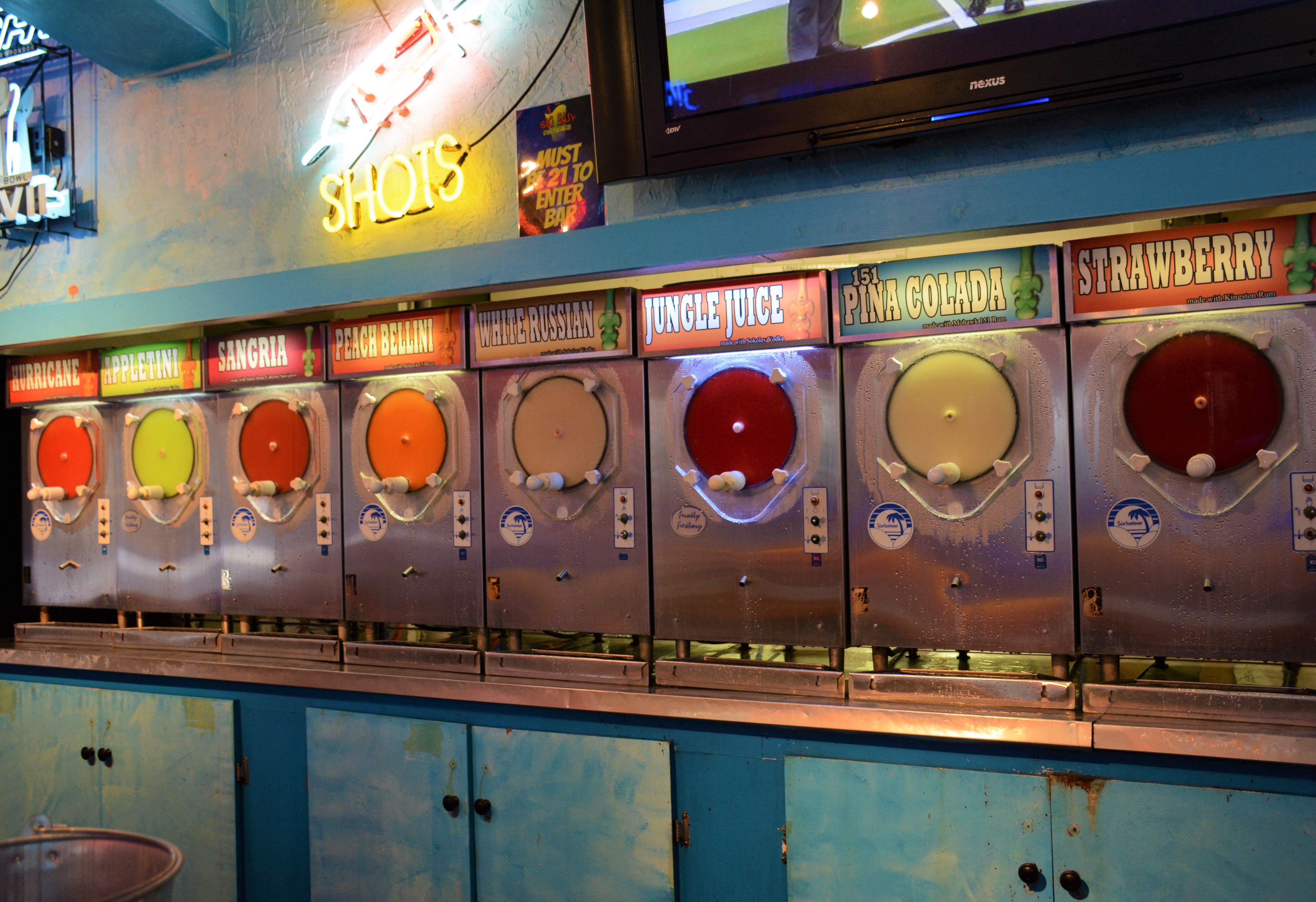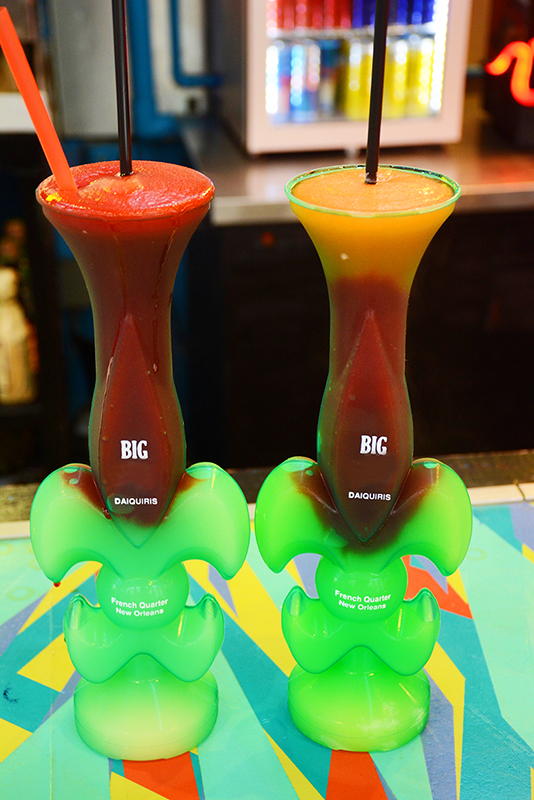Daiquiris: That frozen, boozy concoction we all love … even if we’re not willing to admit it.
When you hear the word "daiquiri", what comes to mind? Whether it’s an umbrella drink by the ocean or a giant tube of green slushy on Bourbon Street, daiquiris are a big part of drinking culture everywhere. And nowhere more so than in New Orleans—home of the drive-thru daiquiri shop, land of the Daiquiri Festival, world of a thousand daiquiris…
Daiquiris are an easy drink to get down and taste great in the hot summer months. And they’re even easier to serve … just pull a knob on a mixing machine and you’re good to go. But what you might not realize is just how much strategy and science actually go into getting that frozen goodness ready to pour into your cup.
For starters, let’s look at some of the icy cold facts. Daiquiris are big business. Depending on where the shop is located, what time of year it is, and what day of the week—even depending on what flavor—any given daiquiri shop can bring in up to $50,000 on a really good day. A shop on Decatur Street on New Year’s Eve near the ball drop might sell over $20,000 in that one night. While a location with prime real estate on Bourbon Street around Mardi Gras will ring in between $50,000 to $55,000 in a single day. Considering that there are hundreds of daiquiri shops in the Greater New Orleans area; that means we’re talking about a multi-billion dollar a year business.
Ramone Martinez worked in the daiq biz for 10 years, working his way up from doorman to manager of seven different daiquiri shops in the Quarter. He even met his now ex-wife at work when she grabbed his butt in the cooler. Just one of many daiquiri-induced love stories out there, I’m sure. Never underestimate the power of daiquiri goggles. In any case, Martinez shared a lot about the secret goings-on of life behind the scenes of a daiquiri shop.
So what exactly is a daiquiri? Basically, the simplest definition is to call it any frozen drink with alcohol (though of course there are non-alcoholic, “virgin” varieties). But for the sake of this article, let’s just say a daiquiri equals frozen alcoholic beverage.

“Most of the daiquiris you see around here are a one-gallon syrup—a concentrate, that they add to four gallons of water,” Martinez explains. “Then they add two bottles of whatever liquor they’ve chosen for that mix. That’s the proportions.” It’s chemicals, it’s alcohol and it’s good. And no one would dare argue it’s the least bit good for you. Then again, according to Martinez, it could be worse. “It’s just concentrate. It’s not heavy by-products or anything like that.” (A little high-fructose corn syrup never killed anyone, did it?) Still, at 1800 calories for a 32-ounce daiquiri, this is definitely not a drink for the diet-conscious drinker. “I don’t think people drink these for health reasons to begin with, really,” Martinez points out. “You’re thinking flavor, sweetness, alcohol, and that’s pretty much it.”
These daiquiri shops are blowing through a whole lot of this sweet concentrated syrup, mind you. Martinez says that on a busy Friday night, a single shop can go through up to 15 to 20 gallons of mix of its most popular flavors, like hurricane or strawberry. And that’s just one shop on one day. The slightly less-sought-after flavors like White Russian still might drain 10 gallons of mix per day.
A lot of the shops work on a pump system. They mix up huge batches of mix and keep them in tanks in the back of their store, then run a line out to their daiquiri machines—like the keg systems that most places use for beer. It takes a half hour to 45 minutes for the stuff to freeze down to the desired slushy consistency, depending on how hot it is on any given day.

And those famous daiquiri-swirling machines?
To begin with, they’re something of an investment. According to Martinez, the average, commercial-grade daiquiri machine will run you about $3000 to $5000 a piece, depending on the size. (A small machine holds about 2.5 gallons of mix while a large has a five-gallon capacity). “Let’s say you have 10 machines in your store,” he says. “And let’s give an average of $4,000 per machine. So that’s $40,000 of machines. Just machines!” But fortunately for the daiquiri-peddlers, at $9 to $13 a drink, it’s easy to get those machines paid off right quick and get your business into the black. “The profit margin is something like 300%,” Martinez explains. “It’s an insane mark-up.” So based on that, it would seem that even a less-popular daiq shop has a chance to be a success.
But what about that? How do so many businesses manage to stay afloat when there is a daiquiri shop literally on every corner? Well, according to Martinez, a shop on every corner is intentional, and a corner location is exactly where they want to be. Because shops on corners get foot traffic from two different streets. He also mentioned the higher concentration of daiquiri shops in the first five blocks of Bourbon Street. Apparently, once you get past the 600 block of Bourbon, daiquiri businesses tend not to do as well. People just don’t want to go that far to get their daiquiri fix.
But location is only one way to beat out the competition. Many shops opt for a gimmick—a look, lively tunes, a fun atmosphere … even a souvenir cup. Martinez talks about how one chain of daiquiri shops uses music as their draw. “Mango Mango was unique in the fact that it was one of the only places on Bourbon Street to offer salsa music and Middle Eastern music to try to drag people in. That’s what some of them strive for—a unique sound or a unique look, or something that’s going to set them apart. It’s just the marketability.”

Looking at the average daiquiri shop on Bourbon Street—bright neon lights, tacky décor, sticky floors, you probably wouldn’t think that these shops are actually going for visually-pleasing. But according to Martinez, that’s precisely one of their strategies. It could be the placement of their neon signs out front, offset to stand out from their competitors’ signage so they’re more noticeable to drunken eyes stumbling down Bourbon Street. Or even the way they organize their rainbow-colored palette of countless flavors in the various machines. “One of the things you will almost never see, if thought is put into it, is two or three reds next to each other. Very rarely will they put a strawberry next to a hurricane,” Martinez explains. “I know it sounds ridiculous, but they’ll break up a couple of reds with a pina colada, or they’ll break up a couple of whites with a red. The first things you see with those kinds of businesses is esthetics.”
Who knew daiquiris were so very scientific?
But it goes even further than that. Have you ever had a particular daiquiri flavor and found yourself surprised and impressed by how much it really tastes like what it’s supposed to taste like? Let’s take king cake daiquiris, for instance—a seasonal special that a few of the shops carry around Mardi Gras. It actually tastes amazingly close to real king cake, right? Well, this is not by luck nor accident. There are actual, real-life chemists working to perfect these recipes, and they come around to the daiquiri shops with multiple versions of a flavor—different colors, slightly different flavor profiles—to allow the shop owners to decide which recipe they like best. Then they mass-produce that version. So don’t take that slushy for granted, it’s a sophisticated cocktail after all! Getting a daiquiri flavor just so involves study, research, trial and error, and a whole lot of skill.
According to Martinez, the daiquiri business is a quick-mix, quick-serve, quick-sell business. It’s all about grab-and-go, drink-on-the-run—the epitome of the New Orleans Go-Cup Culture. Martinez even points out that one of the reasons that a lot of the daiquiri shops sell pizza or “protein on a stick” is so that you get a daiquiri and a slice of pizza and get the heck outta there. He says if you have something in each hand, you’re less likely to stick around. “They don’t want you to stay and hang out in these shops. They want to make more room for more people, to increase revenue. They want you to be able to take your drink and go. You get your product and you move on.” He even says that during big events and particularly busy periods, shops will cut down on the number of flavor options just so that it takes less time for a customer to make their selection. The less flavors there are, the less the customer lingers to make up his or her mind.

You can’t get more drink-and-go than the famous drive-thru daiquiri. I could be wrong, but I’ve never seen a drive-thru daiquiri shop outside the state of Louisiana. Nothing pushes the envelope like a cocktail in a moving vehicle, with only that tiny layer of plastic sealing the straw hole in the cup’s lid to separate you from a drinking and driving violation. Martinez explains a bit about the rules of the beloved daiquiri drive-up window:
“When I was growing up, they didn’t have an open container law. So you could actually drive through, put your straw in it, and have it in your console. You weren’t supposed to be drinking it while you were driving. That’s since changed. Now you can get your daiquiri to go at a drive- thru, but the business can’t put a straw in it, nor can you. That would make it an open container. Passengers can’t either. Open container law applies to everyone in the vehicle. Not in the back of taxis either.”

Daiquiris are an integral part of New Orleans culture. There are a lot of reasons for their popularity: our need for a frozen drink in a constantly warm climate, our drinking in the streets, their quick service, their range of flavors for all tastes, everyone’s love of the souvenir cup...
What used to be the two-day Daiquiri Festival has been bought out by Tales of the Cocktail and expanded into an entire month of daiquiri-related affairs. So this month, “Daiquiri Season”, as it is now officially known, kicks off. For 30 slush-filled days, over 40 venues around the city are hosting daiquiri-inspired events, tastings and even tours.
Among the places joining in on the frozen fun: Compere Lapin is offering Sangria Daiquiris and frozen Passionfruit Margaritas, The Rusty Nail is icing up their “Constance Street Coladas”, and the many bars within Ace Hotel have several fresh daiquiri options to choose from, such as the limoncello-spiked “Sorrentine Summer” at Alto Garden and Grill.
It’s always high season for daiquiris in the steamy weather of New Orleans. Whichever way you slurp it, the daiquiri is gaining even more respect these days. Daiquiris are, by far, the coolest cocktail in town.

